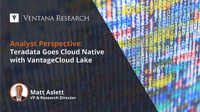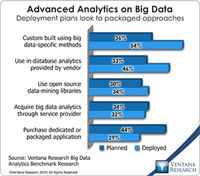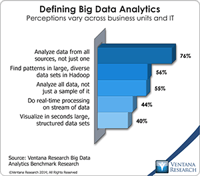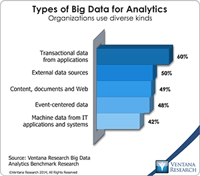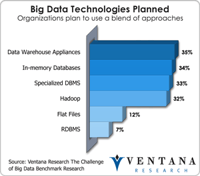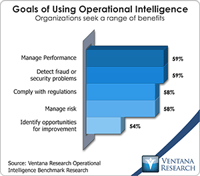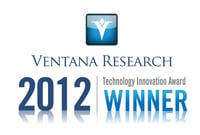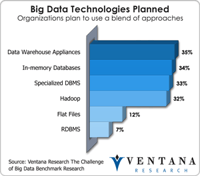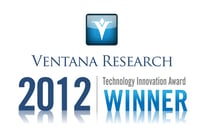Organizations are increasingly utilizing cloud object storage as the foundation for analytic initiatives. There are multiple advantages to this approach, not least of which is enabling organizations to keep higher volumes of data relatively inexpensively, increasing the amount of data queried in analytics initiatives. I assert that by 2024, 6 in ten organizations will use cloud-based technology as the primary analytics data platform, making it easier to adopt and scale operations as necessary.
Read More
Topics:
Teradata,
Data Governance,
Data Management,
Data,
data operations,
operational data platforms,
Analytic Data Platforms,
Object storage,
Vantage platform
This year, Teradata rebranded the Teradata users conference from "Partners" to "Analytics Universe", and there is a reason for it. For decades, Teradata has represented the high end of the analytic database, but new innovations and technologies are adding flexibility to Teradata's licensing as they compete. For the full breakdown of Teradata's Analytics Universe 2018, and my analysis of all the largest announcements, watch my hot take video.
Read More
Topics:
Big Data,
Data Warehousing,
Teradata,
Analytics,
Data Governance,
Data Management,
Data Preparation,
Information Management,
Data,
Digital Technology
At its annual industry analyst summit last month and in a more recent announcement of enterprise support for parallelizing the R language on its Aster Discovery Platform, Teradata showed that it is adapting to changes in database and analytics technologies. The presentations at the conference revealed a unified approach to data architectures and value propositions in a variety of uses including the Internet of Things, digital marketing and ETL offloading. In particular, the company provided...
Read More
Topics:
Big Data,
Teradata,
IT Performance,
Operational Performance,
Business Analytics,
Business Intelligence,
Business Performance,
Customer & Contact Center,
Information Applications,
Information Management,
Internet of Things,
Operational Intelligence,
Teradata Aster
Teradata continues to expand its information management and analytics technology for big data to meet growing demand. My analysis last year discussed Teradata’s approach to big data in the context of its distributed computing and data architecture. I recently got an update on the company’s strategy and products at the annual Teradata analyst summit. Our big data analytics research finds that a broad approach to big data is wise: Three-quarters of organizations want analytics to access data from...
Read More
Topics:
Big Data,
Sales Performance,
Supply Chain Performance,
Teradata,
IT Performance,
Operational Performance,
Analytics,
Business Analytics,
Business Intelligence,
Business Performance,
Cloud Computing,
Customer & Contact Center,
Financial Performance,
Information Applications,
Information Management,
NoSQL,
Workforce Performance,
JSON,
UDA
I had the pleasure of attending Cloudera’s recent analyst summit. Presenters reviewed the work the company has done since its founding six years ago and outlined its plans to use Hadoop to further empower big data technology to support what I call information optimization. Cloudera’s executive team has the co-founders of Hadoop who worked at Facebook, Oracle and Yahoo when they developed and used Hadoop. Last year they brought in CEO Tom Reilly, who led successful organizations at ArcSight, HP...
Read More
Topics:
Big Data,
Teradata,
Zoomdata,
IT Performance,
Business Intelligence,
Cloudera,
Hortonworks,
IBM,
Information Applications,
Information Management,
Location Intelligence,
Operational Intelligence,
Oracle,
Hive,
Impala,
Strata+Hadoop
At its Teradata Partners conference in Dallas, a broader vision for big data and analytics was articulated clearly. Their pitch centered on three areas – data warehousing, big data analytics and integrated marketing – that to some degree reflect Teradata’s core market and acquisitions in the last few years of companies like Aprimo who provides integrated marketing technology and Aster in big data analytics. The keynote showcased the company’s leadership position in the increasingly complex...
Read More
Topics:
Big Data,
Teradata,
IT Performance,
Analytics,
Business Analytics,
Business Intelligence,
Business Performance,
Customer & Contact Center,
Information Applications
Users of big data analytics are finally going public. At the Hadoop Summit last June, many vendors were still speaking of a large retailer or a big bank as users but could not publically disclose their partnerships. Companies experimenting with big data analytics felt that their proof of concept was so innovative that once it moved into production, it would yield a competitive advantage to the early mover. Now many companies are speaking openly about what they have been up to in their business...
Read More
Topics:
Big Data,
Datameer,
Sales Performance,
SAS,
Supply Chain Performance,
Teradata,
alteryx,
IT Performance,
Operational Performance,
Business Analytics,
Business Intelligence,
Business Performance,
Customer & Contact Center,
Financial Performance,
Governance, Risk & Compliance (GRC),
IBM,
Information Applications,
Location Intelligence,
Operational Intelligence,
Workforce Performance,
Strata+Hadoop
At this year’s annual SAP user conference, SAPPHIRE, the technology giant showed advances in its cloud and in-memory computing efforts. It has completed the migration of its conventional application suite and portfolio of tools to operate on SAP HANA, its in-memory computing platform, and made improvements in its cloud computing environment, SAP HANA Enterprise Cloud. The last time I analyzed SAP HANA was when it won our firm’s 2012 Overall IT Technology Innovation Award. Now HANA has been...
Read More
Topics:
Big Data,
Predictive Analytics,
SAP,
Social Media,
Supply Chain Performance,
Teradata,
Mobile Technology,
Operational Performance,
Business Analytics,
Business Collaboration,
Business Intelligence,
Business Performance,
CIO,
Cloud Computing,
Customer & Contact Center,
Financial Performance,
Governance, Risk & Compliance (GRC),
HP,
Information Applications,
Information Management,
Workforce Performance,
CFO,
CMO,
SAP EPM,
SAP HANA,
SAP Lumira,
SAPPHIRE,
Tagetik
Teradata recently gave me a technology update and a peek into the future of its portfolio for big data, information management and business analytics at its annual technology influencer summit. The company continues to innovate and build upon its Teradata 14 releases and its new processing technology. Since my last analysis of Teradata’s big data strategy, it has embraced technologies like Hadoop with its Teradata Aster Appliance, which won our 2012 Technology Innovation Award in Big Data....
Read More
Topics:
Big Data,
MicroStrategy,
SAS,
Tableau,
Teradata,
Customer Excellence,
Operational Performance,
Analytics,
Business Analytics,
Business Intelligence,
CIO,
Cloud Computing,
Customer & Contact Center,
In-Memory Computing,
Information Applications,
Information Management,
Location Intelligence,
Operational Intelligence,
CMO,
Discovery,
Intelligent Memory,
Teradata Aster,
Strata+Hadoop
Our benchmark research found in business technology innovation that analytics is the most important new technology for improving their organization’s performance; they ranked big data only fifth out of six choices. This and other findings indicate that the best way for big data to contribute value to today’s organizations is to be paired with analytics. Recently, I wrote about what I call the four pillars of big data analytics on which the technology must be built. These areas are the...
Read More
Topics:
Big Data,
MicroStrategy,
Tableau,
Teradata,
alteryx,
IT Performance,
Operational Performance,
Analytics,
Business Analytics,
Business Intelligence,
Business Performance,
Customer & Contact Center,
Governance, Risk & Compliance (GRC),
IBM,
Information Applications,
Information Management,
Operational Intelligence,
Oracle
